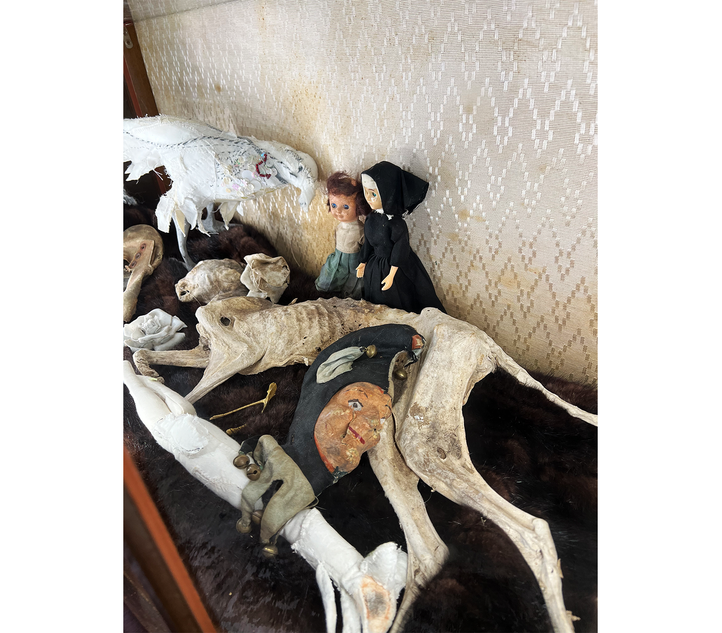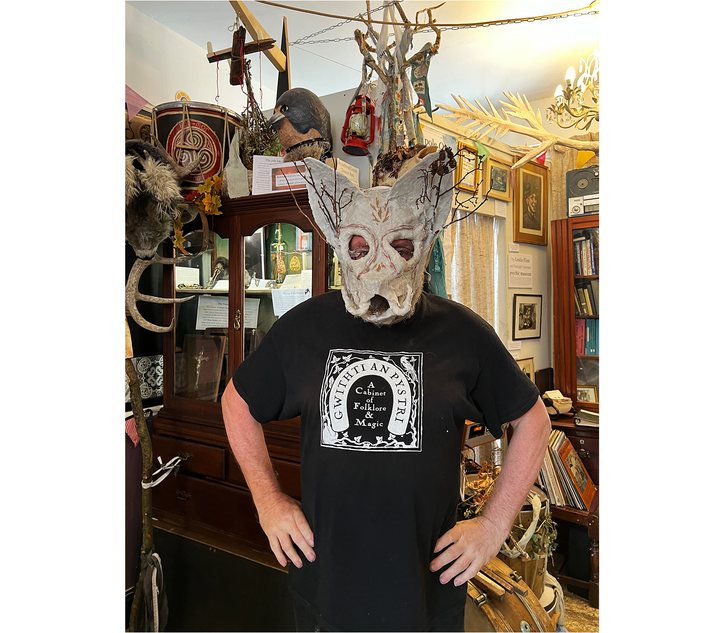On a bright evening in June, Anna and her husband Des donned animal masks and proceeded to a location on the outskirts of Leeds. There they found likeminded people, some in simple disguises like themselves, others in more elaborate costumes: a hobby horse with clacking mouth slung around a woman’s shoulders, an androgynous figure with a pale face holding a sickle and a posy of herbs. And then much raucous, dark merriment commenced.
If this sounds like something from Robin Hardy’s 1973 film The Wicker Man, well, it was. Sort of. The Old Woollen, a former mill converted into an events venue, was playing host to a very special showing of the movie... called Sing-Along-A-Wickerman.
“I’m a huge fan,” says Anna. “It’s possibly my favourite movie of all time. We wore animal masks in the style of what the villagers wore on the May Day parade in the film.”
On the face of it, The Wicker Man might not seem an obvious choice for the sort of audience participation you might find at a special showing of, say, Disney’s Frozen or even the comedic homage to B-movie schlock that is The Rocky Horror Picture Show. It is not what you’d call “big on laughs”, despite having a screenplay by Anthony Shaffer, previously best known for writing the cosy mystery pastiche Sleuth.
In The Wicker Man, Edward Woodward’s uptight Christian policeman Neil Howie arrives on the isolated Scottish island of Summerisle to investigate the disappearance of a young girl. He is horrified to find the islanders indulging in licentious, pagan lives that rub up quite the wrong way against his orthodox religious beliefs, and the deeper he delves, the more horrific the story becomes, until we—and Howie—learn the truth. He has been lured there because he fits the bill for the sacrifice the islanders believe will restore their failed fruit harvest.
The ending, in which the Christian policeman is trapped inside a gigantic wicker man which is then ceremoniously torched, is both bleak and oddly uplifting. There are no white hats riding over the horizon to save Howie; his is not a Hollywood ending. And yet, as the islanders, led by Christopher Lee’s Lord Summerisle, form a circle around the blazing construct, they burst into song—“Summer is icumen in”, a folk number that can trace its lineage to the 13th century—and, honestly, it’s difficult not to tune out from Howie’s final prayers and instead focus on the crackling of kindle, the bleats of goats and the joy and hopefulness of the song.
It’s perhaps all that and the folkish soundtrack composed by American playwright and musician Paul Giovanni—which incorporates a famous musical scene in which Britt Ekland’s lusty landlord’s daughter Willow tries to test Howie’s vow of pre-marriage celibacy—that has seen The Wicker Man receive the sing-along treatment.
As Anna puts it, “The hosts sit with the big screen between them, and the entire movie is played, paused to talk about it and to sing and share jokes. They hold up flash cards with the words to the songs on them. Everyone was laughing. Everyone had a great time.”
And it’s not just The Wicker Man. Although Hardy’s film is often cited as the prime example of folk horror, the whole genre is currently having quite a moment. There were a number of TV shows ploughing this particular furrow over summer, including ITV’s Passengers, Alibi’s The Red King and Netflix’s Bodkin. In Manchester, Maxine Peake took the lead role in a stage adaptation of Robin Redbreast, which gained notoriety as a BBC Play for Today in 1970. While, at the cinema, folk horror has been in pretty rude health ever since The Wicker Man—with recent hits including the starkly beautiful Midsommar, Alex Garland’s dreamlike Men, and this year, the adaptation of Andrew Michael Hurley's novel Starve Acre, starring Matt Smith.
As it happens, Hurley has a new book out, Barrowbeck, which charts the history of one particular town and its folklore from neolithic times through to the present day—and beyond. Adam Nevill has been one of the most commercially successful British folk horror novelists for many years, and his latest, All the Fiends of Hell, adds an apocalyptic tint to the genre. Lisa Rookes’s The Vanishing of Joni Blackwood wraps a domestic thriller in folk horror trappings. My own Withered Hill, published in September, is firmly in the folk horror camp.
Most of all there is moral ambiguity...
But what exactly do we mean by this phrase I’ve repeated so many times now—folk horror? It is a genre with its own tropes, of course. There is usually an isolated, cut-off community. There is an outsider, who represents our world, who blunders in or is taken there. There are pagan practices, a suggestion of older ways and customs. And there is peril and horror. But most of all there is moral ambiguity. This is not the horror of a zombie pandemic or a mad slasher clown or a predatory vampire. In folk horror, there is often internal conflict for the reader or viewer, in that it is not straightforward who the goodies and baddies are meant to be.
“It’s a question I’ve thought about a lot over the past few years,” says Hurley from his home near Preston, Lancashire. “What is folk horror? I think it’s the ‘folk’ bit that really tells us what it’s about; it’s horror that’s born out of beliefs people have, out of folklore, and the way that can include certain people and exclude others.
“It’s often the experience that an outsider has in encountering folklore, or communities that still practice and believe in elements of folklore, that produces the horror. They are coming into something that doesn’t sit within their experience or their moral framework, and they’re being forced to be part of something that they just don’t understand.”
Folk horror also often deals with our relationship to the environment, and that is something more and more people are becoming aware of. “You see the idea of the outsider coming into the community in movies from The Wicker Man to Midsommar, which is kind of a homage to it,” continues Hurley, “but I think it’s very much to do with the landscape as well.
“It’s true of all countries, but in Britain in particular there’s so much that has seeped into the landscape—hauntings and superstition, sites of battles or executions—so it’s got this very dark history, and I think folk horror digs that up, it binds that.
“And along with that comes the idea that folk horror is inherently political. Who owns the land? Who has the right to control certain areas? A lot of folk horror comes from the clash between ordinary people and authority in some guise, like the church or government, over who owns the land.”
Folk horror also uses the trappings of folklore—which can be as spooky as dark rituals or as kooky as Morris dancing—which itself is also undergoing something of a revival. Earlier this month, for example, it was announced that the academic David Clarke of Sheffield Hallam University is leading the first new national folklore survey in 60 years. With £271,000 of government money, the university’s Centre for Contemporary Legend has employed Ipsos to poll almost 3,000 people, so as to address “the lack of robust research evidence into the cultural value of folklore in post-Brexit, post-pandemic, multicultural England.”
“It’s the right time,” says Clarke. “The last major folklore survey in England was in 1964, and so much has changed in the country since then. I’ve been trying to get a new one off the ground for years, but there hasn’t been much appetite for it. Until now. Suddenly, folklore is cool again.”
Nestled on the old high street in the Cornish harbour town of Falmouth is the Museum of Folklore and Magic, run by Steve Patterson, a folklorist and antiquarian of many years standing. This small premises is stuffed to the rafters with the accoutrements of folklore, many of which will be familiar to consumers of folk horror: a bird mask worn for many years at the Penzance “Montol” celebration; mummified animals; an octopus preserved in green chemicals in a jar; a life-size model of the demonic dog Black Shuck.
You would imagine that Steve sits alone amid his collections, save for the occasional visitor with a passion for folklore. Not a bit of it. “We’re really busy,” he says. “People just pass by and come in, and they seem really interested. More and more of them. And I’m seeing a lot more young people who know a lot about folklore and legends. There’s definitely a revival of interest.”
I ask Steve if I can take his photograph, and he immediately sticks on a pig’s head mask. For a while he stands there, staring at me, and it feels as though I have wandered on to Summerisle—or Withered Hill, from my own book, where an eerily similar scene takes place. On the way out, I buy a copy of Hellebore magazine from Steve, now minus his pig’s head.
Hellebore is one of a growing number of (often beautifully produced) folklore magazines. It comes out quarterly, with issue 12 having just been published. For founder and editor Maria J Pérez Cuervo it’s no surprise that there’s a renewed interest in folklore and folk horror half a century after The Wicker Man was released. “Politically and socially, there are many similarities between the current moment and 1970s Britain. In the present day, climate change makes us question our relationship with landscape and nature, the atomisation of social life makes us long for being part of a community, and the increasing secularisation of the world draws us to alternative spiritualities.”
In fact, folk horror is probably the most political of the fantastical genres. “Folk horror can have very conservative themes, with rural communities seen as ‘primitive’ and ‘irrational’,” explains Cuervo. “These views sometimes lead to what I call ‘folksploitation’, where the aesthetics of folklore, such as masks and rituals, which have a powerful visual presence, are exploited for cheap thrills. However, many folk horror fans are drawn to the subgenre because of the folkloric or occult elements; they might be witches or pagans; they’re likely to be fascinated by folklore and the occult too."
Hurley agrees: “I think, in folk horror, we tend to regard those outsider communities as being quite barbaric—but, to them, it’s completely necessary what they’re doing. They don’t see themselves as being hostile or barbaric or vicious or cruel; they’re just doing what they need to do in order to survive.”
Folk horror might indeed be what Cuervo calls folksploitation—and perhaps a Sing-Along-A-Wickerman is Exhibit A in that regard. Or perhaps it’s just that this formerly obscure subgenre is now fully embedded within popular culture—and offers representation to the growing number of people identifying as pagans. “I’m a massive folk horror fan,” says Anna after the sing-along. “I’m pagan myself and so the idea of pagans living in tune with nature on an island cut off from Christian England obviously appeals massively to me. I also love horror. So the two combined are definitely my thing.”















